#molluscan
Text
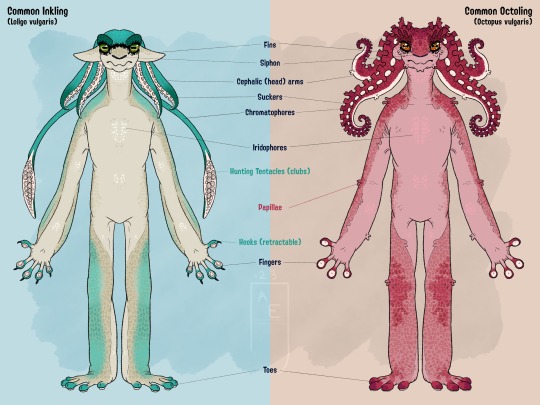

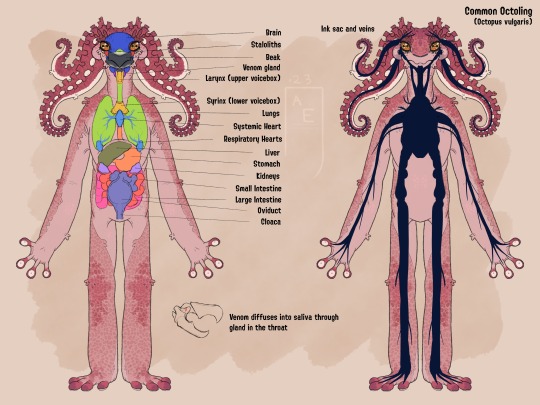
After learning a lot more about squids I was inspired to biology-post once again. Observe my cephalopods, boy.
I wanted to incorporate more traits from the actual in-game design while still adding a healthy dose of creature. I’ll probably still go back and forth between this design and the one i’ve been been using for the past few months, just to get the best of both worlds haha.
Inklings have chitinous teeth in their suckers as well as retractible hooks in the tips of their fingers and toes, the shape and size of which will vary a lot between species. as well. Squids also have a gladius (or “pen”), which is a plastic-like, chitinous structure that basically act as the squid’s backbone and provides support.
Octolings however don’t have this structure, so instead they rely more on the ink veins to support their body weight. Mainly fluid pressure in the legs, which you’ll notice the veins there are denser than an Inkling’s.
Ancient cephalopods made the jump from being muscular hydrostats (no skeleton, all muscle) to true fluid-based hydrostats (using fluid pressure as a “skeleton”) pretty early in their evolution. Their ink sacs grew in size and became their primary form of defence against predators like sharks, which had recently gone terrestrial and were ravaging early molluscan populations at the time.
I’m still not entirely sure how inkfish would change the colour of ink inside their bodies, so for now I’m just going with the headcanon that they do it artificially by ingesting dyes/chemicals before matches, whereas otherwise it would be a deep, inky-black.
#I just really like cephalopods man they’re so cool#my art#xeno tag#xeno inkling#speculative zoology#speculative biology#inkling#splatoon#splatoon 3#Octoling#xeno octoling#Splatoon art#splatoon fanart#Spec evo#spec zoo
256 notes
·
View notes
Text
so here's the deal: my dad was out of my life for twenty years. but recently we've gotten back in touch. he's ten years sober and doing a lot better. he worked as a chef for thirty years and currently works as a sales rep for a major food distro company. so he has access to lots of weird ingredients. he also has a lot of guilt about being out of my life for twenty years. he came up to visit me this weekend. and he brought me an entire frozen octopus. a six-to-eight pound unprocessed frozen octopus. now, my husband is also a chef (the jokes write themselves). so we are more equipped to handle this six-to-eight pound octopus than the average person. now, i am down to eat this octopus. so is my husband. but neither of us has ever cooked with octopus before. we've had calamari before, sure, but never pure octopus. let me emphasize that this octopus had not been processed. the tentacles are pressed against the plastic wrap like laura palmer's tits. it's sitting in my freezer and i am not wholly convinced that it won't come to life when we thaw it. i'm a little squicked out by it and will be way out of my comfort zone when we do cook it. but to not eat it would be to rebuff my father's molluscan olive branch. i'm working on accepting love when it is shown to me, even if that love takes the form of a six-to-eight pound octopus. so i will eat it. i must. the octopus will taste like octopus yes but more importantly it will taste like love. and even more importantly, senshi would want me to do it
#tabby talks#dungeon meshi#senshi#but no really i've been reading dunmeshi and then this octopus arrives and it's like ah yes. time to put the dunmeshi philosophy to the tes#i love when my life echoes the philosophies of the things i read.#dunmeshi
91 notes
·
View notes
Note
…what are the fanfics like in the Splatoon universe..? 👀👀👀
I feel in Splatoon fanfics are stuck in the 2013-2015 era, if you weren't there it was mostly filled with creepypastas, yaoi, jonas brothers, and more. I guess, since Splatoon and our world live in the same time (they are now living in a 2023 Molluscan Era) Squid Squad suffered this wave of fanart and fanfiction that would spread even after their disbandment.

My interpretation of Ikkan would certainly feel really uncomfortable, he's a 30yo dude while a bunch of teenagers still write really questionable stuff about him and his partner. For Ichiya, he finds it really ironic he ended up in the straight fanfics while being gay. And for warabi, he is not so catastrophic and he would take it more as something funny, he is used to it.

At least he inspired Ikkan to make something out of all this
#splatoon#splatoon 2#splatoon 3#splatband#squid squad#diss pair#request#splatoon headcanon#sorry for the wait i was doing commissions and studying ill try to answer as many as i can#im sure in a future ikkan will find a cute manga story about him
98 notes
·
View notes
Photo

This tiny clam, only 11 milimimeters in length, named Cymatioa cooki, was believed to be extinct for 40,000 years, but was recently found living on the coast of Santa Barbara, California, only about 3 of them have been found. In 1937, the molluscan fauna from local Pleistocene deposit described nearly 300 species, with the description of two clams, Rochefortia reyana and Bornia cooki (now Cymatioa cooki). Since then, Cymatioia cooki was believe to be extinct, until now.
Cymatioa cooki is a rare species, and while other related species have been shown to be commensal with other invertebrates, researchers have been unable to determine any specific commensal relationships for it.
Photo: Robin Gwen Agarwal
Reference: Valentich-Scott & Goddard (2022) A fossil species found living off southern California, with notes on the genus Cymatioa (Mollusca, Bivalvia, Galeommatoidea). ZooKeys
Photo description: The clam has a long foot, the shell is ovaloid, pale and translucent. The clam is in sand with small algaes nearby.
328 notes
·
View notes
Text
French startup using mollusks to monitor and protect aquatic environments
Sentinel oysters and other bivalve mollusks are now monitoring ocean water quality and environmental degradation in multiple locations around the globe. And according to molluSCAN the startup who built the software and hardware that connects these shellfish into an environmental warning system, they do so with greater sensitivity, better longevity, and lower cost than non-biological systems.
The company uses aquatic bivalves, such as oysters, mussels, or clams to monitor the environment. These mollusks, which are filter feeders, react to changes in water conditions, helping to detect pollution and other disruptions in water quality.
HOW?
It’s no easy task. To use biological systems or animals as early warning detectors of pollution, you need to know what is unusual behavior. To sense unusual behavior, you have to deeply know usual behavior. In other words, you have to build essentially a simulation or digital twin of the actual animal and model its normal and healthy behavior, and you have to build a sensor system that detects and transmits abnormal behavior.
molluSCAN-eye achieved that thanks to over 20 years of research at the Arcachon Marine Station of the University of Bordeaux. Thanks to that data, the company build what it calls High Frequency Non-Invasive Valvometry: a fancy way of describing its incredibly sensitive technology for monitoring the tiniest of bivalve mollusks movements. When those movements follow irregular or abnormal patterns, the system alerts scientists that something is amiss.
A typical installation includes 16 mollusks, each fitted with a tiny sensor complete with a battery that has years of available power. The sensors, which measure animal behavior 10 times a second, connect to a nearby electronic control box that captures the data from each animal and relays it to scientists or technicians.
16 is the minimum number of mollusks to ensure statistical reliability of the captured signals.
“We use micro-electrodes that are very light, like one gram only outside of water, so it's like tenths of a gram inside water,” says Quinault. “So the animals don't feel anything and we measure every movement that they do, meaning the way they open or close at a very high level of precision down to the micrometer.”
#solarpunk#solarpunk business#solarpunk business models#solar punk#startup#sentinel oysters#water quality#ocean monitoring
8 notes
·
View notes
Text





molluscan kaijuu, leviera | designed by hyakutake tomo (百武朋)
(x)
#ultraman blazar#these are probably up elsewhere by now but i just like having my own little kaijuu gallery :)#next week is dorgo!! the pointy beak-like mouth and foliage is so appealing!#tokupromo#link: telemaga#link: twitter
33 notes
·
View notes
Text






Wiwaxia
(temporal range: 520-505 mio. years ago)
[text from the Wikipedia article, see also link above]
Wiwaxia is a genus of soft-bodied animals that were covered in carbonaceous scales and spines that protected it from predators. Wiwaxia fossils – mainly isolated scales, but sometimes complete, articulated fossils – are known from early Cambrian and middle Cambrian fossil deposits across the globe.[4][6][7] The living animal would have measured up to 5 cm (2 inch) when fully grown, although a range of juvenile specimens are known, the smallest being 2 millimetres (0.079 in) long.[7]
Wiwaxia's affinity has been a matter of debate: Researchers were long split between two possibilities. On the one hand, its rows of scales looked superficially similar to certain scale worms (annelids); conversely, its mouthparts and general morphology suggested a relationship to the shell-less molluscs. More recently, evidence for a molluscan affinity has been accumulating, based on new details of Wiwaxia's mouthparts, scales, and growth history.[7][8]
The proposed clade Halwaxiida contains Wiwaxia as well as several similar Cambrian animals.
20 notes
·
View notes
Text
Do viruses “hijack” the body? “Viruses are more like cone snails than hijackers.” Cone shell venom, weaponized hormones, and predatory insulin overdose. Gila monsters and diabetes treatment. Mimicry. Totally unlike beings contain patches of intimate and detailed sameness. Bodies hold imprints of the other entities’ influence, like a shadow. Where does one creature end and another creature begin?
---
In the twentieth century, the word “hijacking” came to typify the explanation of what viruses do to the cells they infect. How commonplace it is to now say: the virus hijacks the host cell’s machinery in order to replicate itself. [...] However, viruses are not like spaceships, and cells are not just like twentieth-century semitrailer trucks, armored vehicles, or passenger jets whose resources can be plundered and whose operators can be coerced into unwanted journeys. [...] It appears to transparently explain things. But is this a good description of a virus and the creatures it is capable of infecting? [...]
Anthropomorphism and personification of microbial entities in the explanation of virology is a understandable tendency; in this way, viral action is domesticated to the human scale.
But maybe it’s time to practice some resolutely non-domesticating conid-amorphism, some conus-centrism, and see what happens if we forge a new avenue for thinking of viruses in terms of venomous cone snails.
---
Conidae is the taxonomic name for the family of gastropods known more colloquially as cone snails, or predatory sea snails. “One of the most successful lineages of marine animals,” the hundreds of species of Conidae are characterized by their use of complex venoms to capture prey. Some of these snails prey on worms, some on other snails, and some on fish. In 2015, researchers reported that Conus geographus uses an insulin overdose to disorient and disable its fish prey, releasing the toxin into the water.
Insulin appears to be a component of the nirvana cabal, a toxin combination in these venoms that is released into the water to disorient schools of small fish, making them easier to engulf with the snail’s distended false mouth, which functions as a net. If an entire school of fish simultaneously experiences hypoglycemic shock, this should directly facilitate capture by the predatory snail.
The released insulin does not affect the snail itself, because its venom insulin mimics fish insulin, not its own molluscan variety. Venomous snails that hunt worms in this fashion make a different insulin mimic, specific to worms.
---
This may seem like a weird aberration on the part of an obscure life-form, yet cone snails are only one kind of creature that roams the evolutionary space in which one being’s molecules evolve to participate in the physiology of another. There are enough examples of organisms employing these tactics that they are grouped together in scientific reviews of “weaponized hormones.” [...]
For example, the first diabetes therapy drug that works by mimicking the glucagon-like peptide hormone (GLP-1) was discovered by analyzing the venom of the Gila monster. GLP-1 is a hormone released by the gut after eating that stimulates insulin production and slows movement of food through the intestinal tract. The making of a drug that acts like GLP-1 was not a process of exactly copying human GLP-1. For that you wouldn’t need a Gila monster and thousands of years of coevolution between lizards and their prey.
Rather, scientists learned alternative molecular strategies for binding to the hormone’s receptor from the Gila monster venom component.
Perhaps viruses are equally “interested” in glucose control in their own noncognitive way, in that their replication and continued existence is vested in their hosts’ metabolisms. As noted above, they do not possess the means for making the proteins encoded by the genes in their genomes, but rather depend on the cells they infect to do that translation and transcription. [...]
They don’t have their own bodies; they only have their hosts’ bodies.
And bit by bit, through the endless nonillion-fold exploration of evolutionary space -- the space that makes the difference between persisting long enough to be replicated versus falling apart into the wash of biological decay -- it has turned out to be good practice to mimic your host’s cell cycle and metabolic hormones. Different viruses, different hosts, same strategy. [...]
---
If viruses are effective because they mimic human hormones or hormone receptors, this will drive the evolution and duplication of hormones over time because it is advantageous for them to change enough to not be good viral targets. Thus, it has been suggested that some features of human hormonal genes in the placenta arise from their function as viral “decoys” in this tit-for-tat of copying and changing.
It is for this reason that viruses could be thought of in terms of venomous cone snails rather than hijackers.
Not all these mimicry techniques target metabolic processes; many viruses famously encode other proteins that allow them to evade immune detection by attempting to look like parts of the immune system rather than its targets. But there is a theme here. The virus takes on some aspects of the shape of the body that ensures its continuity. This gives rise to totally unlike beings containing patches of intimate and detailed sameness, molecules that bear the same precise contours to fit into a particular hormone receptor, yet perhaps bear no common genetic heritage. Viruses, like cone snails, evolve to be more like what sustains them. It is an uncomfortable form of relatedness, this predatory metabolic convergence, but it cannot be denied that it generates amazing patterns of likeness across biological kingdoms without everything having to be descended from the same line of direct genetic inheritance.
Where does hormone end and hormone-like begin?
If the mimic converges on the original, and places the original under evolutionary pressure to diverge, what is left is a seesawing mirrored relationship of competitive difference and similarity, not an original and a mimic. Even if something has evolved to get away from its mimic, it holds the imprint of that entity’s influence in its difference, like a shadow.
In practical terms, looking into cone snails and viral genomes suggests new ways of making drugs, which are human-made mimics that seek to manipulate physiology by augmenting or suppressing the action of the molecule that has been mimicked.
In philosophical terms on the other hand, that cone snail or amphibian venom gets enrolled in the diabetes epidemic by becoming a blood sugar–controlling drug indicates that anthropomorphic concepts such as hijacking may possibly be the least illuminating explanatory tactic for understanding what viruses do, and are, in relation to their bodies. (Yes, their bodies. That means us).
---
Text by: Hannah Landecker. “Viruses Are More Like Cone Snails Than Hijackers.” e-flux. October 2022. [Bolded emphasis and italicized first paragraph added by me.]
70 notes
·
View notes
Text
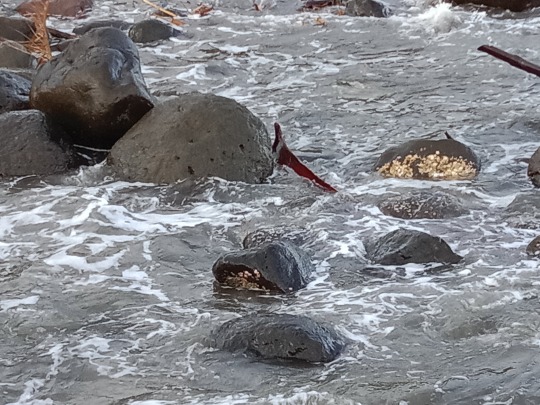
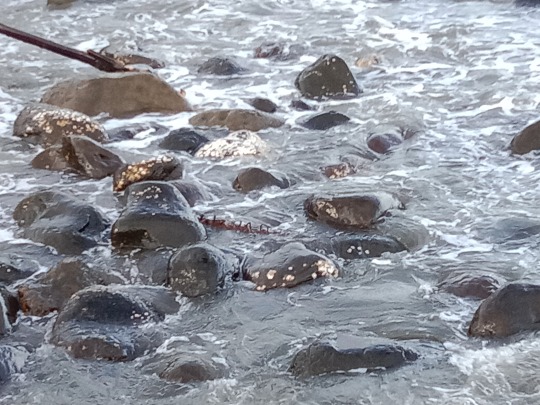
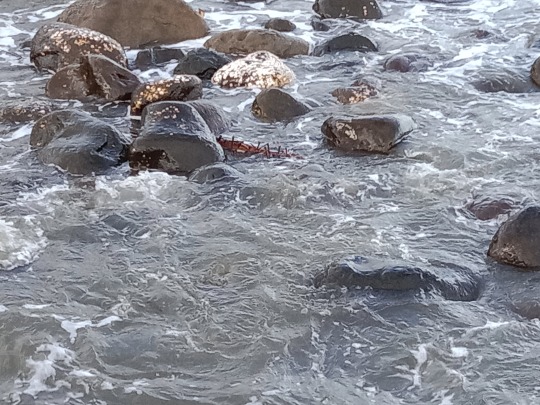
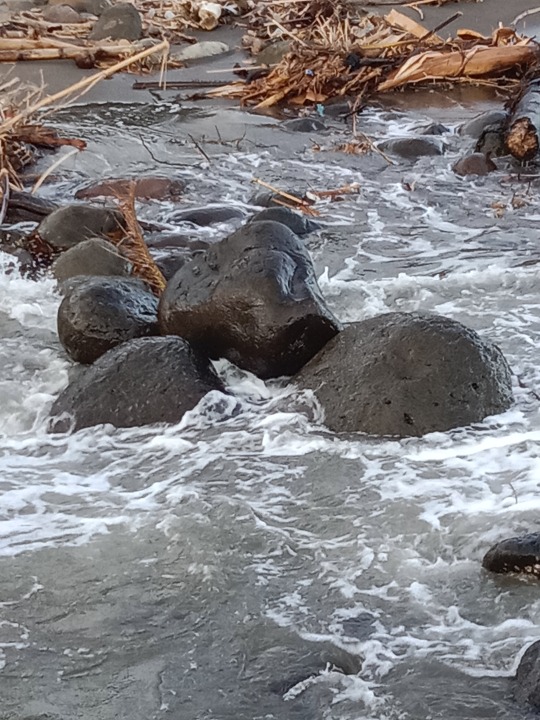
The molluscan sterility that marked the seashore, marked the inshore rocks as well. Expect for a few rocks that bore white blotches of Oyster encrustations, these black boulders were almost lunar of aspect, their black surface devoid of seaweed, periwinkles, barnacles, and even for that matter skittering crabs, they wont to scamper back on the seashore rocks of Andhra Pradesh, India, in literal swarms.
The rocks themselves though were interesting in their physical geology characteristics - nice rounded humps that looked almost man-made, a shoal of rounded rocks as it were.
Dawis Beach, January 26, 2024, Digos City, Mindanao, The Philippines.
#physical geology#beach#rock#boulders#crabs#seashore#sterility#tropics#lunar#india#seaweed#periwinkles#oyster#molusc#mindanao#rounded rocks
3 notes
·
View notes
Text
Sooo BoJack Horseman has anthros:
Mammalian (including aquatic, and non-human primates)
Avian
Amphibian
Reptilian (Lenny Turteltaub; that croc/gator crew member for the Secretariat film)
Piscine (bony fishes; cartilaginous fishes)
Molluscan (Tom JG's squid ex-wife; that slug/snail employee at that shoe store)
Insect
Arachnid (Quentin Tarantulino)
Just. The diversity is pretty cool and actively chosen. 'Cause in my head, I know this one artist whom I feel is like, "dog dog canine wolf fox dog". And in one of my own universes, I limit the species to just mammalian (excluding primates and aquatic), reptilian and avian.
4 notes
·
View notes
Note
Do you think that octolings from different species (example: Blue-Ringed and Mimc) could have a kiddo together? If so what do you think it would look like? totally not asking this because I have an oc that’s a hybrid between these two specifies noooooooo…
Thank you for the ask, and to answer your question: it really depends!
For Octolings (and literally every organism in general), hybrids are relatively rare and are usually only possible if the parent species are closely related enough with a similar karyotype (chromosomes). Almost all hybrids are born sterile, with very few exceptions unfortunately (it's a controversial topic in Molluscan society within itself and I won't get into that here haha).
Generally hybrid children are more common in closely-related species, like if they share a genus/family or something (eg. two species of bobtail squid). More extreme hybrids like the one you've just mentioned ( blue-ring and a Mimic) are very rare, and any further than that and you end up hitting a wall where it becomes outright impossible as the genetic difference is just too extreme.
Hybrids are pretty neat though! they are often a blend of traits between their parents, sometimes they can even have heterotic traits and they'll end up looking completely different which is really cool.
For a Mimic/Blue-ring hybrid, I'd imagine a small Octoling with super long, gangly limbs and a lot of papillae. Maybe some longer webbing between the tentacles, or some little flecks/patches of blue iridophores here and there? You could do a lot with this lmao.
#I tend not to think about species as much when I'm drawing Octolings (I really should more) but yeah!#also I really like talking about genetics can you tell#xeno tag#speculative biology#splatoon#inbox chatter
11 notes
·
View notes
Note
Hello! Following Milk's idea, any other topics or fun facts you want to talk about? I hope you're having a good day!
Oh hoh hoh!! Another change to spit out random facts I know? Thank you very much, Moth!!
(I hope you are having a lovely day yourself! *hugs you*)
The topic today is statocysts, specifically those of cephalapods!
Secondary fun fact to start us off: translated literally, "cephalopod" (Squid, octopi, nautilidae, cuttlefish, or other members of the molluscan class Cephalopoda) means "Head-feet"! Which, if you've ever looked at an octopus, you can understand:
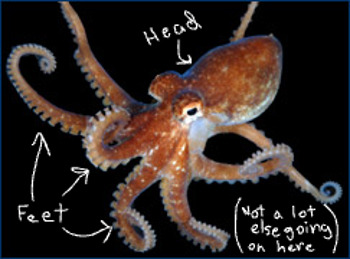
So. Cephalaopods live in the water, right? This means they don't hear the same way humans, or indeed most vertebrates do. Humans hear because the sound hits the eardrum, gets passed on through middle and inner ear, and then is sent up the auditory nerve to the brain.
Cephalopods have two sacs near the base of their brain called statocysts. They're filled with fluid and lined with hair cells that connect to the brain via nerves. This makes them similar to human ears, except that statocysts have a little piece of calcium carbonate inside them called a statolith.
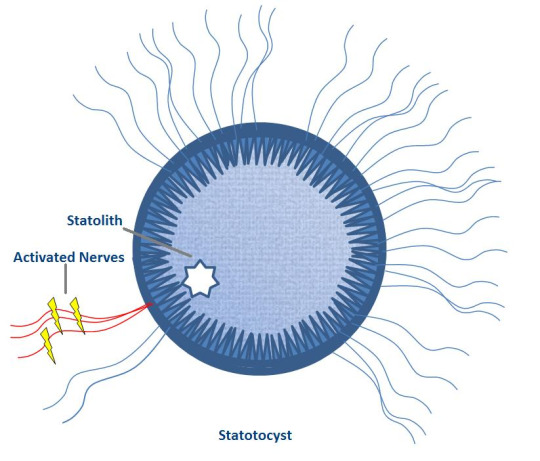
When the cephalopod moves, the statolith moves around too, which allows the hair cells, and therefore nerves and brain, to process the movement. This is a little like how the human vestibular system detects balance and equilibrium. (How you know if you're upright or leaning to the side, laying down, etc.)
However, since cephalopods have these statocysts instead of vertebrate ears, they do not exactly "hear" sound, but instead sense how fast particles are accelerating due to the vibrations that a human might hear audibly.
This became a field of study partially because of an abnormal amount of dead squid washing up on beaches in the early 2000s. It was discovered that certain human equipment, such as sonar or air guns used to search for oil, were damaging the statocysts in nearby cephalopods. The sounds caused lesions, swollen nerves, and other injuries that would have caused the squid to lose their ability to orient themselves.
This spurred on a more direct look into how human technology is affecting marine life, as well as the vastly unknown field of cephalopod sensory processing.
Here are some sources for those who are curious:
>1
>2
>3
#I'm sorry this took me a while#I read about this several years ago and I wanted to be sure none of my information was out of date#I hope I didn't make any mistakes in this summary#(And my deepest apologies if I did)#I just think it's interesting#We don't know a lot about the head-feet so there's a lot of neat studies going on#Going to shut up now#not mbs#asks
9 notes
·
View notes
Text
I’m curious as to know, What Cupcler’s quote unquote “biology” is.
I’m assuming he has a circulatory system, considering he has blood (which is blue. Also if his blood is diluted, it would be his favourite colour. Irrelevant, but interesting to think about.) The only thing is, he has no neck. Leaving me to believe;
His head and body are actually separate parts entirely. It’s like a mollusk/ Crab situation, and he is not a mammal, despite the mimicry of one, which the body being more of a shell.
It’s an interesting concept. Cause it implies that the Body and the cup doesn’t necessarily have to be connected. It is beneficial, for movement and defensive purposes. It would also make sense for this to be the case because the cups he sell (at least the ones he grows, due to the fact that they have legs) are actually alive, as in they can be grown, via planted. With the cups being the head and they find bodies to “attach themselves to.” With his uncle being a crab cup with no body, this is highly likely, with the body being unnecessary for survival. Also makes sense for the blue blood.
He could be an individual, the only case of a Cup based entity. Or there could be more; Cups without bodies, only legs that move around and live like that, either searching for bodies or not. That there could be cup people, with bodies, who can abandon them if in danger.
An interesting theory, though this begs the question; Why is Cupcler the only one that we know of? Well, cause he murdered the rest. (Personally I’d like to think that the “first” Dave, was likely another Cup, he shattered to claim the title. I have no evidence for this, as Dave isn’t mentioned again.) Cupcler has murdered before, he confessed to it himself. The details he leaves out is who or what these people are/ were. So while not explicitly stated and with a high likelihood of being improbable, it is not impossible. It would also be to claim bodies that he could fit into, ones that may be better than the ones he had previously.
Of course this means that his head and body have two different circulatory systems.
If his brain can fit inside the rim of the cup, the heart and the veins can be lower in the sides of the cup. The brain (which he has, surprisingly) needs blood to function. If there is no way of blood getting to it, then there would be no way for the brain to continue, leaving him dead.
You may say: “While, sure that makes a bit of sense, but how do they stay connected?” I have another theory.
It may be the brain has higher powers that initially stated, keeping the head and body together. Added to this, the sound of him turning his head, is a sound the brain produces to give the illusion that his head is connected to something. His head clearly has control over the rest of the body, with the claws, his healing, his ability to grow limbs and his dancing abilities.
He has telepathy, who’s to say this can’t extend to telekinesis? He’s clearly smarter than he lets on, however he’s seemingly only intelligent directly to his own abilities and advantages. There is something that keeps the body connected to the head, which allows the body to do what the host want it to. Do I have evidence for this? Not really. My evidence is flimsy at best; but the brain at the very least can alter the body to do what it desires. Such as the addition of new limbs, incredible healing rates, and extreme strength, which wouldn’t make sense compared to his fragile head.
Would they not be the same material? It would be logical, if they were biological the same. But they are clearly not, despite having the same blood colour. Because the body can handle more than a material as flimsy as porcelain, hardened clay or glass, some of the most common materials for the common cup. With the statements of his abilities above, it would simply make more sense for his body to be more like a molluscan, than a living statue of the same easily broken resource.
Or maybe he like Pokémon evolution-ed into the Cupcler from a cup plant.
Cupcler: The Cup type Pokémon; Typing: Dark Grass.”
21 notes
·
View notes
Text
Snapdragon's
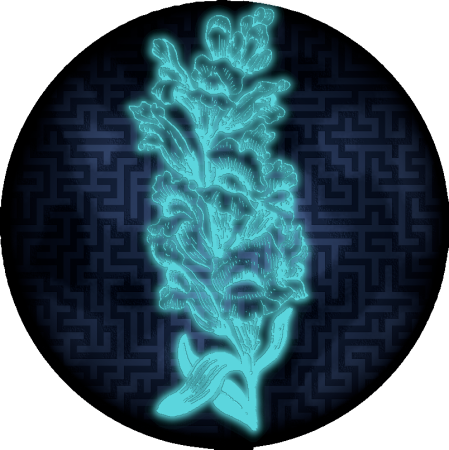
“Are you sure about this?” she asks skeptically.
“We’ll be OK, I promise.” In truth, he didn’t know if it was safe. He’d been second-guessing himself since they entered the mountain. But he had faith in where they were going. He looks down once more at the strip of paper in front of him. An address he can barely make out, with a very clear drawing of a flower taking up half the page.
The couple works their way through the district’s winding streets and alleys. Being built, quite literally, inside the mountain, the district grew darker and darker as they ventured further. Flashing neon signs and halogen lights abound, the locals too poor to afford the holographic displays seen downtown. A few storefronts are entirely candlelit. Signs outside the buildings are written in many alien scripts, a stark contrast to the Three Universals seen downtown.
This mountain, located on the outskirts of a bustling spaceport city, falls into a legal loophole which landowners took advantage of to create extremely low-rent housing. In the years since, the district has housed all manner of creature and culture from across the stars. Locals aren’t dressed in the business suits and flashy garb of the tourists. They wear their native clothes in varying states of dishevelment. They speak their native tongues, sell the wares they made on their home planets, and pray to their own gods and divinities. They go about their daily business - but not without commotion.
A catfolk vendor and a rocklike customer argue over the sale of a melon. They speak in a language neither of our couple understands, though the lady can make out a few swears here and there. Frustrated, the customer smashes the melon on the ground. The vendor screams and leaps out at the customer, claws exposed. Further down, a huge amoeba purchases groceries from a six-armed grocer, absorbing the produce in vacuoles and carrying on. A crab-like creature with a broken leg plays an erhu for tips. A ferocious sculpture is repaired by an avian outside a temple, resembling something like a cross between Jesus, an octopus, and a twelve-armed bloodthirsty warlord.
The two search the crowds and storefronts for the flower, but can’t find it anywhere. Florists, grocers, co-op gardens, even clothing stores and wallpaper prints. None of them have that exact flower. They ask any and all locals they run into for directions. Of the ones they talk to, none of them seem to recognize it - not the writing, nor the design inside.
But they didn’t let the city pass them by. The two also used the chance to explore the district’s exotic amenities, to have a little fun in-between. They stopped for beverages at a stall and watched a worm drummer’s performance (which had been going on for five days prior). They spent some credits at a dance-machine with options for up to eight limbs. They stopped by an arcade and, mesmerized, watched a molluscan play Tetris for… much longer than they should have. They skimmed the various shops of the district, even if they couldn’t make out most of the signs and prices. Small trinkets of varying toxicity and beauty here and there, books and tablets and drives of any and all knowledge, knock-off brands alongside relics - and, of course, folks peddling them at each and every corner.
“Buy some alum-venom! Fresh alum-venom!” A naga merchant peddles the couple in a raspy voice, flashing a brown vial in their faces. “Does wonders to a mammal’s skin!”
“Isn’t that stuff toxic?”, she responds.
The snake vendor hisses, and the couple hurry out of the vendor’s reach, clasping each other’s hands and running for dear life.
❦
Now out of sight of the vendor, the two end up lost. This part of the district is dark and damp, and nobody else seems to be present. They see a series of pools, water filling them from the ceiling and draining below. The fun and joviality they experienced not too long ago now fills with a lingering sense of unease.
“Maybe we should ask someone for directions,” she says.
Reluctantly, he obliges. They keep walking until they spot a storefront with someone sleeping outside. It’s a stout figure, wearing an officer’s cap, bearing two turquoise arms and legs attached to a turtle-like shell. Underneath the cap is a single shut eye the size of a basketball.
“Entschuldigung?” He cycles through a few more languages before the figure acknowledges. “Excuse me, sir?”
The eye opens, and the figure awakes. The eye rises from the shell, revealing a mouth and a neck that slowly extend to a height nearly twice that of the lovers. A low-pitched gurgle resounds from the figure’s shell.
Our Romeo gulps, swallowing his fear.
His Juliet gasps, but stands her ground.
The figure’s eye wanders for a minute before spotting the couple. The figure gurgles once more, then speaks. “Oh! Yes. Sorry. Forgot I was on dry land. Can I help you?” Its voice is shrill and hoarse, like an out-of-tune violin.
He composes himself. “I need help finding this address. Do you know where it is?”
The figure bends its neck and reads his page. “Yes, I know where this is.” It thinks for a minute, then motions its nightstick to its left. “Go down that alley a few blocks. Take the staircase up…” it counts on its fingers “…four levels. You’ll see a store with votive candles directly to your right. Go right and continue that way until the lights turn blue.”
He takes a minute to note the directions in his head. “Thank you, sir.”
“Anytime.” The figure gets up from its seat, gurgling, and descends into a nearby pool. As it submerges, the gurgling turns into the baritone humming of a foreign tune.
❦
After taking the (surprisingly long) staircase up and walking past the votive candle shop (made from skulls), the two end up in a small back-alley filled with rugged housing. A couple of the streetlights are out. There isn’t a single flowerbed or touch of green anywhere. “This is supposed to be the place.”
The two of them look around for any signs of the flower, but the badly lit corridor makes figures hard to discern. Dejected, they turn around to look for someone to help them. Due to the dim lighting, she trips on a loose stone in the road, and he leaps on the ground to break her fall. Tending her wound, he spots something out of the corner of his eye. It’s a sign. There’s nothing written on it, just a graphic hidden under a dead streetlight. He approaches the sign. It’s got that same drawing of the flower on it.
“This is it! This has to be the place!”
She walks over to the sign. “Are you sure this is it?”
“It has to be.”
“But are you sure this is the place?”
There’s a moment of tense silence. “No.”
A wooden door with a doorhole sits next to the sign. He knocks on it thrice. They await a response.
The doorhole opens. Two steely eyes stare from it.
“Hi, I was invited here by a friend?” He puts the paper in view of the doorhole. “This is Gabriel Lennox.”
The figure reads the paper. “Ah, yes, we’ve been expecting you. Come in.”
The door opens, revealing an ashen-skinned waiter with cobalt hair and two ram-like horns. They enter the building and find themselves directly beside a kitchen. “This is the staff entrance. I’ll take you to the host.”
The kitchen itself seems as diverse and bustling as the rest of the district. An elephantine sous-chef prowls the kitchen, keeping it running like a well-oiled machine. Actually, ‘well-oiled machine’ isn’t a bad analogy for the rest of the restaurant, either. Giant cogwheels, some moving, some stationary, line the walls and make up some of the chairs. Steam can be seen emanating from pipes in and out of the kitchen. The whole place is lit in warm colors. Unlike the rest of the district, the fact you’re inside a mountain is made very well known here. The walls proudly display their stony texture, with a few ores exposed here and there for decorative effect.
The group travels upstairs. The air seems to be easier to breathe now. More tables are visible, some already being seated. The waiter leaves them on a platform near a giant axle in the center of the place. The axle rises from a rather large hole in the ground, burning embers lying many meters below. The hole is stagnant at first. Then, a gust of hot air emerges, sparks from a newly lit fire below barely missing the couple’s feet. Seconds later, a dragon emerges. The girl is horrified; the boy grips her hand and the two take a huge step back.
“Hey, you made it!” The dragon speaks in a surprisingly soft, almost comical voice. “Welcome to Snapdragon’s. It’s great seeing you again, Gabriel.”
“You know this dragon?”, she asks Gabriel.
“We go back a bit.”
The dragon turns to her. “Ah, this must be your ladyfriend. What’s your name?”
“Ruby,” she responds hesitantly.
“Pleasure to meet you.” The dragon whips his tail around and slowly places its tip in front of her. “Don’t worry, it’s prehensile.”
She stands there, a little bewildered. Gabriel motions for Ruby to shake it like a hand. She does, and the dragon smiles.
“I’ll take you to your seats. I saved the best in the house for you two.”
The dragon walks them further through the restaurant. The place is surprisingly spacious, and the dragon isn’t too large - about the size of a minivan - so he walks ahead of them with little discomfort.
Gabriel and the dragon do a little catching up, while Ruby follows and takes in the scenery. She notices a piano played by an octopus-like creature in the distance, playing a calming and somewhat jazzy tune. A shadowy, almost fluid character stands by with a saxophone in hand. Parties made of smoke and scale, fur and feather, plasma and precious gem, sit at the other tables dressed in their best. She sees old friends re-uniting, family junctions, business dinners, and other couples out enjoying themselves.
“I got this whole place for cheap”, the dragon says. “It used to be a warehouse. The company folded a while ago and left some of their machinery behind. A dozen weeks later, I refashioned it all into Snapdragon’s.”
“Why a restaurant? In this part of the port, nonetheless?”
“Same reason as everyone else. The rent’s cheaper. The neighborhood is… variable, sure. But you can prosper here in a way you can’t downtown. You’re not under the microscope.”
“How’s it working out for you?”
“Pretty well so far. But, you know how restaurants are. Most of them close within three years of opening. Very few survive more than ten.”
“Have you tried advertising the place?”
The dragon scoffs. “I’m not the best at advertising, but we seem to do alright with the word-of-mouth we get.”
“Could you have made the invitation a little less cryptic, at least?” Gabriel laughs a little saying this.
“Yes, I suppose I could’ve. But then it wouldn’t have been as fun for you two to find.”
The dragon turns to look directly at Gabriel. Gabriel can see anguish in the dragon’s eyes, betraying the smile just below. He’s covered in a number of obscured bruises. The dragon’s voice softens further, and he moves in closer. ”I’ve lost a lot these past few years.” He looks to his side, then sighs. “A lot of things have gone wrong. Things I’d rather not think about. Things that keep me up at night. You’ve seen sides of me I’m not proud of.
“But through it all, you’ve been there. You’ve always been a shoulder to cry on, someone to look forward to talking with.
”There’s an old Earthlander saying: ‘Friends are like the stars; you can’t always see them, but they’re always there.’ I’d like to think that holds true with you. Our friendship has changed, but I’m glad to have it.
”You’ve done more for me than you can imagine. Now,” the dragon says, motioning to the balcony, “it’s time for me to repay the favor.”
The couple ascends the staircase to the balcony, and the dragon readies their table. Ruby and Gabriel take their seats, and are taken aback by the view. As it turns out, this warehouse was built close to the surface of the mountain. Our dragon friend broke through part of it and made a balcony with a view of the entire spaceport caldera. The digital and holographic displays of downtown turn into brilliant pastels on an otherworldly canvas. High-rises soar and show their lustrous designs. Even the advertisements, once a pedestrian’s eyesore, now seem like gentle brushstrokes of some greater beatific mural. Spaceships can be seen flying through the sky, reduced to the size of birds by their distance. And encapsulating it all are the other mountains of the caldera, rising like Fuji over the Tokyo horizon, painted shades of pink and purple by the setting sun’s light.
The couple is entranced by the view. Ruby reaches her hand across the table toward Gabriel’s. He notices, and reciprocates. The two’s eyes catch, and they both smile at each other in a way only lovers can. They turn once more to the landscape before them, taking it all in.
It was their landscape now. Theirs to share, theirs to enjoy.
❦FIN❦
I wrote this story a few months back as a gift for a friend. You can see it with some (temporary) assets and custom formatting on my website.
#short fiction#short story#original story#science fiction#sci fi#science fantasy#spaceport caspar#ræl's writings#ræl's artwork
7 notes
·
View notes
Text


the Molluscan
Leviera from Ultraman Blazar
3 notes
·
View notes
Note
Hello hello!!
Could x get shark/cephalopod themed pronouns?
Of course! Here you are :]
🦈🦑 Shark/Cephalopod Themed Pronouns (Very Big List!)
shark/shark/sharks/sharkself
fe or fin/fin/fins/finself
te/teeth/teeths/teethself
jaw/jaw/jaws/jawself
gill/gill/gills/gillself (see also: six/gill - a type of shark)
scay/scale/scales/scaleself
great/white/greats/greatwhiteself
mer/hammer/mers/hammerheadself
bull/shark/bulls/bullsharkself
thresh/thresher/threshs/thresherself
mako/mako/makos/makoself
hunt/hunt/hunts/huntself
breach/breach/beaches/breachself
blue/blue/blues/blueself
til/cartilage/tils/cartilageself
spy/hop/spys/spyhopself (referring to a behaviour seen in great whites, in which a shark peeks their head out of the water)
-
ce or ceph/cephalo/cephs/cephalopodself
octo/octopus/octos/octopuself
nautil/nautilus/nautils/nautiluself
si/squid/squids/squidself
cuttle/fish/cuttles/cuttlefishself
ten/tac/tens or tacs/tentacleself
si/siphon/siphons/siphonself
ink/ink/inks/inkself
fin/fin/fins/finself
beak/beak/beaks/beakself
camo/flage/camos/camouflageself
mim/mimic/mimics/mimicself
dart/dart/darts/dartself
mol/molluscan/mols/molluscanself (referring to the larger class of animals that cephalopods can be found in)
#my lists!#neopronoun blog#neopronouns#neopronoun coining#mogai pronouns#requests!#animal prns#ocean prns#cephalopod prns#shark prns
19 notes
·
View notes